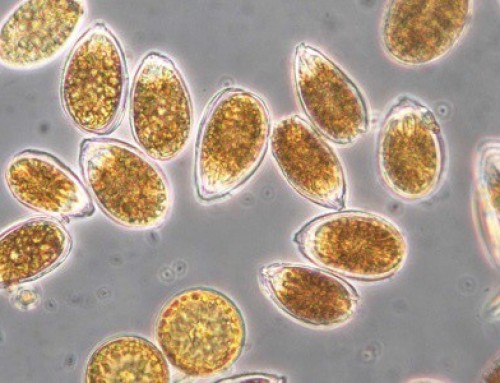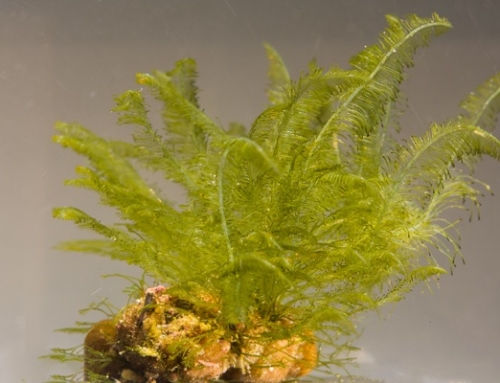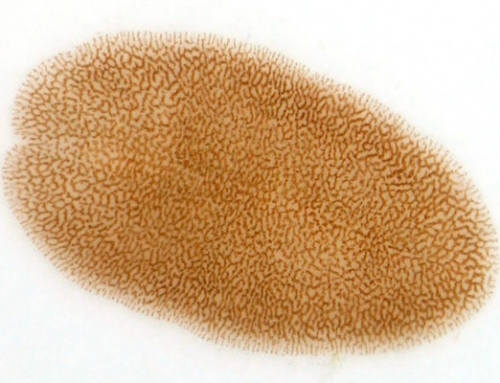Que no debes ignorar
Surgen como pequeñas y brillantes esferas aisladas, normalmente agarradas a la roca, carentes de movimiento y muy decorativas. Pueden pasar semanas e incluso meses sin que esta situación varíe, pero de repente, un buen día descubrimos que la roca del acuario está tapizada por estas pequeñas perlas verdes (y las menos habituales pardas y rojas). En grietas, bajo repisas, o directamente expuestas a la luz, no hay un centímetro cuadrado que esté libre de amenaza; incluso sobre el tejido de muchos corales (caso habitual en sarcophytones y otros corales cuero).
Y ya es demasiado tarde. Con una capacidad reproductiva sorprendente, y sin apenas depredadores naturales, es muy difícil frenar su expansión. Las algas burbuja deben ser eliminadas en el momento en que son detectadas en el acuario ya que si llegan a expandirse pueden convertirse en un auténtico problema.
La denominación de algas burbuja es muy amplia y engloba especies muy variadas que comparten varias características comunes como la forma esférica, ausencia de tallo y reproducción por esporas.
Veamos las más habituales en el acuario.

Ventricaria ventricosa
Es probablemente la más infame y habitual en los acuarios. Los aficionados suelen conocerla como valonia ventricosa, pero lo cierto es que hace ya mucho tiempo que fue renombrada como integrante única de su propio género: ventricaria. (Olsen & West, 1988)
Suele crecer aislada, con forma de vejiga de hasta cinco centímetros de diámetro y es fácilmente reconocible por tener una única y minúscula raíz con la que se sujeta firmemente a cualquier superficie. Cada vejiga es un individuo y también una única célula con una membrana dura y brillante que hace de esta especie un bocado difícil y poco apetecible para la mayoría de los herbívoros (especialmente cuando alcanza cierto tamaño).

Valonia utricularis
Se trata de un alga con forma de vejiga alargada y curvada que crece en compactos racimos firmemente unidos entre sí. Cada vejiga o célula puede tener una longitud de hasta cuatro centímetros, aunque lo habitual es que en cada racimo la mayoría sean mucho más pequeñas.
Crecen de forma desordenada y su membrana es relativamente delicada por lo que hay que tener cuidado al retirarlas para que no revienten y se liberen sus esporas. Afortunadamente la raíz de estas algas burbuja suele ser bastante débil y bastará con deslizar un objeto plano por debajo del racimo para retirarlas de una pieza.

Valonia macrophysa
Similar a la anterior aunque algo más pequeña y redondeada, estas algas burbuja suelen hincharse en su extremo superior lo cual hace que el racimo parezca más ordenado. Se trata de un alga muy común en todos los mares y océanos (Índico, Pacífico, Atlántico, Caribe, Mediterráneo…)

Valonia fastigiata
Fácilmente reconocible por su estructura ramificada, cada célula se divide creando un pequeño vástago lateral formando su característica silueta la cual es fácil de confundir con algunas especies del género salicornia. Las vejigas suelen ser pequeñas, de no más de un centímetro de longitud y ligeramente curvadas.
A la izquierda de imagen se puede observar un racimo de estas algas burbuja, muy similar al ejemplar de salicornia mostrado a su derecha. Son algas burbuja poco comunes en los acuarios, originarias del océano Índico y Pacífico occidental.

Valonia aegagropila
Encontrarse estas algas burbuja en el acuario no es una buena noticia y desaconsejo la introducción de cualquier coral o roca que tenga alguna de ellas en su superficie. En mi opinión se trata de una de las especies más difíciles de eliminar.
Se trata de un alga formada por diminutas vejigas unicelulares (de unos pocos milímetros), con forma alargada y ramificada, lo cual no suele ser evidente a primera vista por la forma compacta en que se agrupan los racimos. Su pared celular es bastante delicada en comparación con el resto de algas burbuja, mientras que su raíz le permite adherirse con fuerza a cualquier superficie, lo cual hace que sea casi imposible retirarlas de una manera limpia y sin liberar esporas en el agua. Se trata otra de las especies ampliamente extendidas por todos los mares y océanos, incluso de aguas no tropicales.

Dictyosphaeria cavernosa
Se trata de un de las pocas algas burbuja que no suelen suponer una amenaza. Crece de una manera muy irregular y con forma de vejigas deshinchadas. Las paredes, de textura granulosa, son en realidad una agrupación de pequeñas algas burbuja unicelulares. Crece despacio y suele ser alimento fácil para cualquier animal herbívoro, especialmente erizos, por lo que no suele durar mucho en el acuario.
Esta especie de algas burbuja está distribuida por el océano Índico hasta Polinesia y también en el Caribe. En el acuario es poco habitual y dada su forma y color, es fácilmente confundida por una esponja.

Colpomenia sinuosa
Se trata de una alga de color amarillo que crece en forma de vesículas deshinchadas de gran tamaño (algunas de hasta diez centímetros de diámetro). Tienen una pared gruesa y correosa lo cual hace que sea poco interesante para muchos herbívoros. Su raíz es moderadamente fuerte, por lo que es fácil retirarla de una sola pieza sin romperla.
La distribución de estas algas burbuja es una de las más amplias, llegando a estar presente en las frías aguas del Antártico (aunque no en las aguas canadienses ni del Ártico).

Botryocladia sp
Se trata de un género de algas burbuja fácilmente reconocibles por su color rojo, motivo por el cual no pasan desapercibidas en el acuario. Suelen formar racimos formados por células de no más de uno o dos centímetros dependiendo de la especie y la mayoría son translúcidas lo que permite poder observar los pequeños cistocarpos de color negro (órganos reproductivos).
Muy apreciadas por todos los animales herbívoros y con una membrana no muy dura, suele ser rápidamente devorada en el acuario y en raras ocasiones se convierte en una amenaza. Dependiendo de la especie, es posible encontrar estas bellas algas burbuja en casi todos los mares del mundo, incluidas aguas subtropicales, aunque son más frecuentes en el océano Índico e islas del Pacífico.

Bornetella sphaerica
Una especie de algas burbuja muy diferente a las demás. Se agrupa en cientos de pequeñas células que se compactan en un racimo con forma esférica de entre uno y dos centímetros de diámetro. Cada pequeña vesícula está unida a un tronco central por medio de un filamento que porta las esporas reproductivas.

Boergesenia forbesii
Estas algas burbuja de forma alargada y unos cinco centímetros de longitud suelen crecer en pequeños racimos no ramificados en el que todos los individuos están unidos a la misma raíz. Tienen un marcado carácter epifito, es decir, gustan de crecer sobre el tejido de otros organismos, principalmente algas aunque también pueden hacerlo sobre corales.
Su pared celular es algo más delicada de lo que cabría esperar en algas burbuja de este tamaño, por lo que hay que tener especial cuidado si intentamos desprenderlas. Tienen una amplia distribución geográfica por lo que resulta bastante habitual encontrar algunas de estas algas burbuja en las importaciones de roca viva.
Control de las algas burbuja en el acuario
Depende mucho de la especie, y aunque puede decirse que la mayoría constituyen una importante amenaza y deben ser eliminadas tan pronto sean localizadas, hay otras que son rápidamente consumidas por cualquier animal herbívoro por lo que no son una preocupación.
No existe un método de control infalible y a veces resulta complicado eliminar ciertas especies de algas burbuja de nuestro acuario; como en la mayoría de las pestes, lo mejor es la prevención y la observación: adquirir roca y sustrato de proveedores fiables, ponerla en cuarentena y observar bien su superficie.
Lo más efectivo contra las algas burbuja más problemáticas como la ventricaria ventricosa y algunas especies de valonia es aplicar una combinación de tres acciones:
- Reducir los nutrientes
- Retirar las algas de forma manual
- Introducir animales que consuman las algas
Reducir los nutrientes
Es el primer paso para combatir las algas burbuja es debilitarlas y para ello nada mejor que limitar al máximo sus fuentes de energía: nutrientes disueltos en el agua y luz. Dado que son algas con bajos requerimientos lumínicos, capaces de prosperar incluso debajo de cornisas y lugares con poca luz, resulta muy difícil debilitarlas reduciendo su exposición a la luz (salvo que tengamos un acuario sin corales y no nos importe cubrir el acuario durante un par de semanas).
Tal vez la mejor forma de reducir nutrientes sea cultivando otras formas vegetales que compitan también por ciertos oligo elementos e incluso el espacio, tal es el caso de las algas calcáreas como la halimeda, o simplemente coralina. Muchos aficionados instalan filtros scrubber o refugios con chaetomorpha o ciertas especies de caulerpa.
Retirar las algas de forma manual
Puede ser complejo y laborioso pero por lo general resulta imprescindible si queremos eliminar el problema. Las algas burbuja tienen una característica común: en el interior de su célula se encuentran unos pequeños órganos reproductivos (denominados cistocarpos), cuando la vejiga alcanza la madurez (aproximadamente un tercio de su tamaño final), es capaz de producir esporas, las cuales serán liberadas al agua si se rasga la membrana. Lo cierto es que si el acuario está maduro y dispone de un buen sistema de filtración, las posibilidades de que una espora se convierta en alga son bajas y mueren la mayoría, pero un acuario inmaduro puede ser como un campo recién arado esperando a las primeras lluvias para llenarse de malas hierbas.
Cada especie se retira de una manera diferente: ventricaria ventricosa y algunas valonias como la macrophysa o la boergesenia forbesii se pueden retirar fácilmente con los dedos de la mano como quien coge uvas de una parra. Por contra, otras algas burbujas requieren de mucho cuidado y conviene emplear un destornillador de punta plana para romper su raíz antes de extraerlas. Si descubrimos algún racimo de valonia aegagropila, lo más sensato es sacar la roca del agua y retirar las algas fuera del acuario, con mucho cuidado de no romperlas.
Introducir animales que consuman las algas
Esta podría ser la gran solución: nos gastamos un dinerillo en meter algún pez o invertebrado y…pues no, lo siento mucho pero no.
Son pocos, si alguno, los animales que han probado ser verdaderamente eficaces contra las algas burbuja, vamos a comentar los posibles candidatos:
Mithrax sculptus
Este simpático cangrejo es omnívoro y realmente no come algas burbuja salvo que tenga mucha hambre, lo cual no suele suceder en un acuario con peces. Existe la falsa creencia de que come algas burbuja, pero lo que en realidad hace es pinchar las más pequeñas e inmaduras (que afortunadamente no tienen esporas reproductivas)

Esto facilita que sean consumidas por otros animales como erizos y algunos peces. Los cangrejos mithrax se han hecho muy populares y son ya un animal bastante habitual en tiendas especializadas.
Ercolania endophytophaga
Se trata de un nudibranquio especializado en el consumo de algas del género valonia. Este pequeño molusco es capaz de penetrar en el interior de una vejiga sin romperla y comérsela desde su interior. Pero lo más sorprendente es en el interior de las algas burbuja donde realiza su puesta de huevos algo que le ofrece dos grandes beneficios: la seguridad ante cualquier posible depredador y la disponibilidad de alimento para su prole tras producirse la eclosión.

En la imagen de la derecha se puede ver un nudibranquio ercolania junto a una puesta de huevos en el interior de lo que parece una valonia utricularis.
No obstante, está lejos de ser una solución definitiva ya que se trata de un animal que plantea una serie de problemas:

- Es muy delicado y presa fácil para cualquier pez de los «habituales» (hexataenia, synchiropus y cualquier lábrido por poner algunos ejemplos).
- Es un animal altamente especializado, lo cual supone que cuando se acaban las algas burbuja, no encontrará comida y se morirá irremediablemente.
- Es muy difícil de encontrar en tiendas especializadas y cuando está disponible suele ser a un precio muy elevado.
Siganus magnificus
Algunos aficionados aseguran que se trata de un pez que gusta de consumir algas burbuja. En realidad se trata de un pez bastante «caprichoso», yo he visto ejemplares que en pocos días limpiaban un acuario de valonia, pero también he visto otros que daban buena cuenta de caulastreas y otros tipos de corales.

Otros invertebrados
Si se trata de eliminar pequeñas algas burbuja, cuya pared celular aún no está completamente formada, podemos ayudarnos de algunos caracoles aunque hay que tener en cuenta que por lo general solo las consumirán si están muy hambrientos. Posiblemente el más eficaz sea el tectus, un caracol que alcanza gran tamaño y dispone de una potente y afilada radula capaz de masticar estas algas.
Otra opción son algunas especies de erizo, como los tripneustes y los diadema (olvidarse de los mespilia y echinometra), los cuales comerán alguna de estas bolitas, aunque solo como último recurso si no hay otras algas disponibles.





Deja tu comentario
Debe iniciar sesión para escribir un comentario.